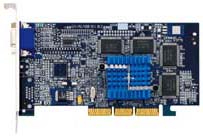
Original Link: https://www.anandtech.com/show/470
Gigabyte GA-MG400 Matrox G400 AGP
by Anand Lal Shimpi on February 3, 2000 4:02 AM EST- Posted in
- GPUs
Just under a year ago, Matrox dazzled the market with the release of their G400 chip. The G400 was a contender, during the time of the TNT2 and the Voodoo3, that went in somewhat of a different direction than both NVIDIA’s and 3dfx’s products.
Instead of focusing entirely on performance, the G400 brought to the table some very useful features that, when push came to shove, helped put cards based on the G400 in systems that would have otherwise held a TNT2 or a Voodoo3.
Features such as DualHead, the ability to output to two monitors using a single G400 card, and Environment Mapped Bump Mapping, a feature used to increase the realism of textures by adding “bumps” without increasing polygon count, both soon became buzzwords that had the entire industry talking about.
When the competitors announced their next generation products, some of the first questions to be asked were “does it support Environment Mapped Bump Mapping?” and “will you have a DualHead option?” It is clear that Matrox made quite an impact on the consumer level 3D card market with the release of that one chip.
While the performance of the G400 was and still continues to be quite competitive, the solution lost in terms of the best hardcore gaming solution and thus never gained the acceptance into the gaming market that Matrox had originally hoped for. Part of the reason of the poor acceptance from gamers, who decided to go for a TNT2 or Voodoo3 based solution instead, was because of the relative unavailability of G400 based cards as well as the very high price tag that the top of the line G400MAX carried.
Had the cards been available back in May of 1999 when Matrox first officially announced the cards, even at the prices they debuted at, there would be a few less TNT2 and Voodoo3 owners around today and a few more satisfied Matrox customers. But, that wasn’t the case, and although Matrox worked their hardest to make sure that they didn’t make the same mistakes with the execution of the G400’s release as they did with the G200, they created new pitfalls in the process.
In an attempt to correct one of their major mistakes, although a bit late, Matrox signed a deal with Gigabyte to allow them to produce graphics cards based on the G400 chipset. Since Matrox wanted to remain the sole producer and manufacturer of retail boards based on the G400 yet also wanted to gain increased market acceptance, they went to Gigabyte with a unique offer.
Why Gigabyte?
Why would Matrox, a graphics card manufacturer, want to team up with Gigabyte to produce OEM versions of their G400 products? First, you must understand Matrox’s motives behind this move.
Matrox wanted to keep their profits high, but at the same time needed help gaining market acceptance. Normally when you want to gain market acceptance you go to an OEM computer manufacturer and get them to use your graphics cards in all of their systems, or at least offer them as an option. Matrox had done that, but what Gigabyte offered was another unique approach to gaining market acceptance
If you recall, towards the end of 1998 we began to see motherboards featuring integrated G200 chips. This was a smart move on Matrox’s behalf since it did not interfere with their G200 card sales yet it increased the acceptance of the G200 into the market since there were now motherboards shipping to OEMs with on-board G200 chips.
Since the G400 is too expensive of a product to integrate onto a motherboard as a low-cost solution, Gigabyte decided to place another part of the G400 card onto the motherboard, and in doing so took off around 10% of the overall cost of the card. What part is this? The VGA BIOS.
VGA BIOS on Motherboard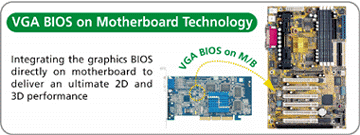 Most
motherboards currently ship with 1 – 4Mbit BIOS ROMs on-board. Gigabyte’s theory
was that if you used some of the storage area on the motherboard’s ROM to store
what would normally be placed on the video card’s BIOS, you could cut costs
by not having to include a BIOS on the graphics card itself. This would also
mean that in order to use a graphics card without a BIOS, you’d need to be using
a motherboard that had the VGA BIOS on the on-board ROM, and if Gigabyte were
the only motherboard manufacturer that supported this, then you would have to
buy a Gigabyte motherboard.
Most
motherboards currently ship with 1 – 4Mbit BIOS ROMs on-board. Gigabyte’s theory
was that if you used some of the storage area on the motherboard’s ROM to store
what would normally be placed on the video card’s BIOS, you could cut costs
by not having to include a BIOS on the graphics card itself. This would also
mean that in order to use a graphics card without a BIOS, you’d need to be using
a motherboard that had the VGA BIOS on the on-board ROM, and if Gigabyte were
the only motherboard manufacturer that supported this, then you would have to
buy a Gigabyte motherboard.
From Matrox’s standpoint the deal was equally as beneficial. Matrox only had to produce the G400 chips and ship them to Gigabyte. Gigabyte would then produce cards based on the G400 but would include the VGA BIOS in the BIOS of their motherboards, thus adding another requirement for the video card, you’d have to own a Gigabyte motherboard that supported this feature. What this would accomplish is a greater market acceptance of the G400 chip, without truly interfering with Matrox’s G400 card sales.
And the technology that we’re talking about here was ‘creatively’ dubbed by Gigabyte as VGA BIOS on Motherboard. The first G400 based card Gigabyte has released that takes advantage of the VGA BIOS on Motherboard technology is the 16/32MB Gigabyte GA-MG400.
How it Works
Unlike an integrated AGP controller, the GA-MG400 is a physical card that plugs into your AGP slot just like a regular graphics card. This allows you to replace the graphics card later on, even if the graphics card you are upgrading to has it’s own BIOS. The beauty of the VGA BIOS on Motherboard technology is that the cost saved by taking the BIOS chip off of the graphics card isn’t absorbed into the motherboard’s cost, since the data that would normally be stored in the VGA BIOS is just stored in the motherboard’s BIOS.
If you go out and buy the GA-MG400, you will find a box that is clearly labeled “Gigabyte Motherboard Required.” But just having a Gigabyte motherboard doesn’t mean that the MG400 will work on your motherboard, you first have to make sure that your BIOS is up to date and has the appropriate data to function as both your system and your video card’s BIOS.
As of the date of publication there are 11 Gigabyte motherboards that support VGA BIOS on Motherboard and the MG400, those boards are:
GA-BX2000
GA-BX2000+
GA-6BXC
GA-6BXE
GA-6CX
GA-6CXC
GA-6VXE+
GA-6VX-4X
GA-6ZMA
GA-6ZXC
GA-7IX
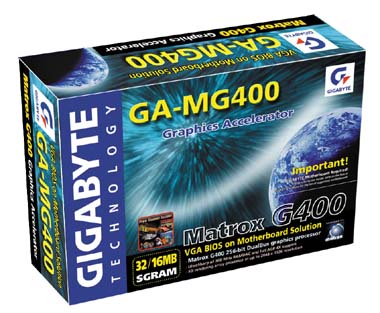 Secondly,
you can’t just have a supported motherboard, you also have to make sure that
the BIOS supports the VGA BIOS on Motherboard technology. So before you can
plug in your MG400 you may have to flash the BIOS on your Gigabyte motherboard
in order to allow for the card to work properly. With no video BIOS on the
motherboard the MG400 will fail to start since it has no BIOS to start up from.
Secondly,
you can’t just have a supported motherboard, you also have to make sure that
the BIOS supports the VGA BIOS on Motherboard technology. So before you can
plug in your MG400 you may have to flash the BIOS on your Gigabyte motherboard
in order to allow for the card to work properly. With no video BIOS on the
motherboard the MG400 will fail to start since it has no BIOS to start up from.
For a listing of all supported motherboards and correct BIOS updates, visit Gigabyte's MG400 Drivers/BIOS page at: http://www.giga-byte.com/gigabyte-web/sw400agp.htm
The other method to get the MG400 is by purchasing it bundled with a Gigabyte motherboard. In this case, the BIOS revision of the bundled motherboard will already be up to date and you can simply set your system up without having to worry about flashing your BIOS.
The biggest question both of these methods raise is that of availability, while OEMs have a fairly easy time getting their hands on Gigabyte products, the end users often have a difficulty finding Gigabyte motherboards, much less video cards. And the chances of finding a Gigabyte motherboard bundled with a Gigabyte video card are even slimmer. Distribution is one area that Gigabyte sincerely lacks in, hopefully they will eventually correct this as there are quite a few end users out there looking to purchase their products.
Specifications
Key Benefits |
|
256-bit DualBus architecture |
|
True
128-bit external bus to video memory
|
|
Full AGP 2X/4X device with Multi-threaded Bus Mastering |
|
True Environment Mapped Bump Mapping |
|
Vibrant Color Quality2(VCQ2) Rendering |
|
32-bit internal precision specially enhanced for multi-texturing using 32-bit source textures |
|
32-bit
Z-buffer including 8-bit stencil buffer
|
|
Symmetric Rendering Architecture
|
|
DirectX 6, PC 98/99, Broadcast PC,
DirectShow, OpenGLcompatible
|
|
High speed integrated RAMDAC (up
to 300MHz) with UltraSharp RAMDAC technology
|
|
Display up to 2056 x 1536 @ 32bpp |
- 2D Acceleration
Benchmark-winning 2D performance optimized for true color operation at high resolution
UltraSharp RAMDAC technology for highest quality analog output
Full acceleration of all GDI and DirectDraw functions
Linear frame buffer
Programmable, transparent BLTter
Linear packed pixel frame buffer
32-bit ultra-fast VGA core - Advanced 3D Features
3D Rendering Array Processor delivers up to three times the speed of the MGA-G200
Floating Point 3D Setup Engine with dynamically re-allocatable resources
Environment Mapped Bump Mapping
Single cycle multi-texturing
Vertex and table fog
Specular highlighting (any color)
True color ARGB Flat and Gouraud shading
Vibrant Color Quality2(VCQ2) Rendering
Texture sizes up to 2048 x 2048
Filtering support Including
11 level mip-mapping support
Bilinear Filtering
True eight-sample per pixel trilinear filtering
Anisotropic filtering
Alpha blending & Z-buffer support
Guard Band Clipping
Single, Double or Triple buffering
3D-image effects combined with no exclusion conditions
Sort independent (full scene) anti-aliasing
Vector/edge anti-aliasing
Hardware dithering including dithering of LUT textures
- Driver Support
Windows 9X, Windows NT 4.0, Windows 2000
DirectDraw, Direct3D, DirectVideo, and ActiveX
OpenGL ICD for Windows 95/98 and NT
Vibrant Color Quality2
Taken from our G400 & G400MAX Review
One of the most marketable features the G200 carried was its Vibrant Color Quality (VCQ) rendering, interestingly enough, VCQ isn't really a technology at all, rather a system Matrox defined. The G400, naturally, is back with a new "version" of VCQ rightfully entitled Vibrant Color Quality2 (VCQ2). VCQ2 offers the same advantages the original VCQ rendering system offered, which was basically the ability to render all scenes with 32-bit accuracy internally, then dither the final image down to 16 bits of color per pixel. This gave Matrox the best looking 16-bit rendering available at the time, needless to say that the G400 renders all scenes internally with 32-bit accuracy and then dithers them to 16 bits of color per pixel provided that you are set to render in 16-bit color mode.
If you're not running in 16-bit mode, then you have the option of enabling what Matrox likes to call VCQ2. Basically VCQ2 is a combination of a 32-bit color mode, a 32-bit Z-Buffer, and the same 32-bit accuracy performed with all internal calculations. This combination provides for the absolute best possible visual experience available in a game, unfortunately for Matrox, the G400 isn't the only chipset with this capability. The NVIDIA Riva TNT2 is also capable of achieving the same image quality in this case, the only limiting factor here is the design of the board and the RAMDAC which will make the picture look somewhat (albeit barely noticeable) less crisp as that of a G400. Matrox also boasts support for what is known as Stencil Buffering, or the ability to render only the visible part of a scene, a performance booster in ideal cases.
Matrox can't claim that they're 100% unique with the idea behind VCQ2, but since the term is copyrighted, they can always claim that no other company has VCQ2. Bottom line? Don't get fooled by the marketing, you're not getting anything special with VCQ2, NVIDIA has had this for a while now.
Environment Mapped Bump Mapping
Taken from our G400 & G400MAX Review
While Matrox can't claim exclusive rights to the technology behind VCQ2, they can claim that they are the only desktop accelerator in this scope that supports a technology known as Environment-Mapped Bump Mapping. Bump Mapping is a technology that allows a texture to appear more realistic by the inclusion of individual bumps in the texture. If you look closely at a painted wall in real life (not in Q3A world guys) you'll notice that the wall isn't perfectly smooth, there are bumps and numerous imperfections. Bump Mapping essentially allows for those bumps to be put on walls and basically any textures in a game. It truly makes your gaming experience something else. NVIDIA supports a type of bump mapping known as embossed bump mapping, which can be considered a form of what we're talking about, but not the best and most realistic. Embossing is basically a cheap work around to avoid Dot Product 3 or Environment-Mapped Bump Mapping, the latter being the implementation Matrox used in the G400.
Instead of manipulating a standalone texture map to make it "look" like it has bumps on it, Environment-Mapped Bump Mapping adds a third texture to the rendering sequence (in cases where both an Environment Map and a Texture Map are present). The third texture, or the bump-map, is nothing more than the basic environment map with bumps and grooves. Since the G400 is capable of single pass multi-texturing (as well as 2 pixels per clock in the event that only a single texture is being processed), the Environment Map and Texture Map are processed first in 1 clock cycle, then the Bump-Map is added on top of them in 1/2 a clock cycle. It's simple addition of textures, unfortunately the added 1/2 clock cycle required by the Bump-Map does tend to slow things down by a noticeable degree.
Using Rage Software's Expendable, an incredible looking game, there was a noticeable drop in frame rate when Bump Mapping was enabled near points of extensive use of Environment-Mapped Bump Mapping. If you look at it from the point of view of the G400 chip itself, it makes sense that there would be a drop in performance as you're making the processor calculate information for another 1/2 clock cycle just so you can look at pretty water - the things we make our computers do ;)
The two screenshots below are some of the most impressive uses of EMBM, but unforuntately, since the release of the G400 back in May of 1999, this single screenshot has been one of the only good uses of EMBM. While we have seen it in other games, the water in Expendable was the best use of EMBM we have ever held witness to.
No Bump Mapping
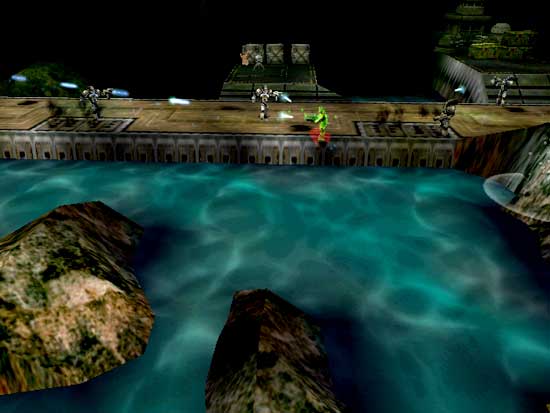
Environment Mapped Bump Mapping

EMBM support in current games isn’t as great as we originally expected it to be. Very few of the major titles support EMBM, and the games that do support it, don’t make extensive use of the technology. And in the areas that they do use EMBM extensively in, the G400 doesn’t have a high enough fill rate to keep up a playable frame rate.
256-bit DualBus Architecture
Taken from our G400 & G400MAX Review
In AnandTech's original coverage of the Matrox G200, the first feature praised was the G200's 128-bit DualBus Architecture, a technology that was really much more than a marketing ploy. The success of the 128-bit DualBus Architecture inspired Matrox to make another quantum leap ahead of the quickly approaching competition with the new 256-bit DualBus Architecture (DBA), exclusive to the G400. The same analogy that applied to the G200's 128-bit DBA still applies to the 256-bit DBA, let's first take a look at what the 128-bit DBA did for the G200:
Imagine that you are on an 8-lane highway. The 8-lanes of this highway allow for more traffic to move from one end of it to the other, however there is a catch. The cars on the highway can only be moving in one direction at a time, meaning that all the cars must either be moving up the highway or down it but not both at the same time (all 8-lanes move in the same direction). Consider that the limited functionality of an internal 128-bit Data Bus when applied to video cards, on any given CPU clock cycle the data being transferred via the internal 128-bit Data Bus can only flow in one direction (to the graphics engine). On the following clock cycle the data can be transferred down the bus in the other direction (from the graphics engine). While this approach does have its benefits, when dealing with 2D images and bitmaps where the data that must be transferred down the bus remains quite small (less than 128-bits) there is a much more efficient way of approaching this.
Let's take that highway example from above, now instead of making that highway an 8-lane highway let's split it up into a 4-lane going and a 4-lane coming highway. Meaning that at the same time 4 lanes of cars can be traveling on the highway in the opposite direction of 4 lanes of cars on the other side of the highway (4 lanes can be leaving the city while 4 lanes can be entering). If there is no need for 8 lanes to be open for transportation in any one direction then the first 8-lane highway wouldn't be as efficient as this modified 4/4-lane highway. The same theory applies to the Matrox G200.
Instead of occupying the entire width of a 128-bit bus to transfer data in 64-bit chunks why not create a dual 64-bit setup with one bus dedicated to sending data to the graphics engine and the other dedicated to receiving data from it. This is what the G200's 128-bit DualBus architecture is, in essence it is 2 64-bit buses offering the same combined bandwidth as a single 128bit data bus while allowing for data to be sent in parallel to and from the graphics engine.
This time around, instead of splitting the 128-bit bus into two 64-bit buses, Matrox doubled the effective bandwidth by implementing dual 128-bit buses, making up a 256-bit I/O bus for transferring data between the G400's graphics engine and the memory buffers. Keep in mind that although the G400 features an internal 256-bit DBA, the external memory bus (bus connecting the G400 chip to the memory on the board itself) is still 128 bits wide. This brings up the need for extremely fast access to the memory, which is more than adequately taken care of using the 166 SDRAM on the G400.
DualHead
The MG400 unfortunately does not feature the 2nd VGA output connector and Matrox TVO chip that enable the DualHead functionality on the Millennium G400 and G400MAX boards from Matrox. So if you’re looking for DualHead, you’re still going to have to go through Matrox.
Memory Configurations
The MG400 is available with either 16MB or 32MB of SGRAM, like the G400 boards from Matrox.
As you’re about to see from the benchmarks, the extra 16MB of SGRAM on the 32MB version of the board is well worth it once you get into the higher resolutions.
Drivers
The GA-MG400 is a supported device in Matrox’s current driver release (v5.50.005), however if you select the GA-MG400 device you won’t be able to successfully boot into Windows.
Matrox has identified the problem and say that it is most likely related to the fact that the MG400 does not feature the same G400 BIOS that is present on the other G400 cards. While they are working on a solution for the problem, there is an easier way to use the Matrox drivers with the Gigabyte card.
Instead of allowing Windows to search for the best driver for your card, manually select the Matrox G400 AGP driver from the list of all drivers contained within the G400 driver set. A quick reboot later and you’re back in business, running with Matrox’s driver on your Gigabyte card. You will have to download the TurboGL driver separately and use that alongside the drivers to get the maximum performance out of your setup.
Why would you want to use Matrox’s G400 drivers instead of Gigabyte’s GA-MG400 drivers? Well, the MG400 drivers from Gigabyte are very out of date and don’t perform nearly as well as the Matrox drivers. While Matrox claims that they will be working with Gigabyte in the future to get these driver issues resolved, you’re probably better off going to Matrox for the drivers, especially since the Gigabyte drivers are nothing more than the Matrox Powerdesk drivers with the Gigabyte logo.




The Competition
Let’s take a look at the competing cards and their approximate costs:
Matrox Millennium G400
(32MB) DualHead - $179
Matrox Millennium G400 (16MB) DualHead - $149
NVIDIA TNT2 (32MB) - $100
NVIDIA TNT2 Ultra (32MB) - $150
And then we have the Gigabyte cards:
Gigabyte GA-MG400 (16MB)
- $90
Gigabyte GA-MG400 (32MB) - $120
The Test
We were limited in our motherboard choices since the motherboard had to support Gigabyte's VGA BIOS on Motherboard technology, thus we picked the GA-6CX, an i820 Motherboard, and the GA-7IX, a Slot-A Athlon motherboard for the tests.
|
Windows 98 SE Test System |
||||
|
Hardware |
||||
|
CPU(s) |
Intel
Pentium III 733 provided by Memman |
AMD
Athlon 800 AMD Athlon 500 |
||
| Motherboard(s) |
Gigabyte
GA-6CX
|
Gigabyte
GA-7IX
|
||
| Memory |
128MB Samsung PC800 RDRAM provided by Mushkin |
128MB
PC133 Corsair SDRAM
|
||
| Hard Drive |
IBM Deskstar DPTA-372050 20.5GB 7200 RPM Ultra ATA 66 |
|||
| CDROM |
Phillips 48X |
|||
| Video Card(s) |
Gigabyte GA-MG400 16MB (default clock - 125/166) Matrox
Millennium G400 16MB DualHead (default clock - 125/166) NVIDIA
RIVA TNT2 32MB (default clock - 125/150) |
|||
| Ethernet |
Linksys LNE100TX 100Mbit PCI Ethernet Adapter |
|||
|
Software |
||||
|
Operating System |
Windows 98 SE |
|||
| Video Drivers |
|
|||
|
Benchmarking Applications |
||||
| Gaming |
GT
Interactive Unreal Tournament 4.04 UTbench.dem |
|||

The first thing that is established here is that the GA-MG400 and the Millennium G400, each equipped with 16MB of SGRAM, perform identically. Thus we can also say that the 32MB version of the MG400, which wasn't available at the time of publication, will perform identical to the 32MB Millennium G400. The only real difference between the Millennium G400 and the GA-MG400 being that the Millennium G400 supports DualHead operation.

Here we see a slight shuffle in the standings. The 16MB of memory on-board the MG400 is suffocating it as the resolution/color depth increases. But for $90, as long as you don't mind not having DualHead support, the MG400 does a very nice job of performing. One thing we failed to mention earlier but must point out is that not only does the card perform well, but the image quality is excellent.
The additional $30 or so for the 32MB version would be well worth the investment in terms of performance.

The MG400 still performs respectably for its price class but the 16MB memory is clearly a limitation. Once again, with the 32MB G400 representative of how a 32MB MG400 would perform we can't help but recommend going for the slightly more expensive 32MB version.

Matrox's TurboGL driver makes sure that the driver limited performance at 640 x 480 of the three G400 based cards is quite respectable in comparison to the competition.

We get a similar situation at 800 x 600 with the 550E as we did with the 733, the numbers are just lower because of the slower CPU.

Once again, the 16MB memory limitation is very evident in this picture. Just look at the performance increase going to 32MB of on-board memory offers at the top of the chart.

With the Athlon things are not much different, but this time around the TurboGL driver is making use of the Athlon's 3DNow instructions to help to boost performance at low resolutions.


This is virtually the same picture we got on the Intel platforms, the 16MB MG400 performs midway between a regularly clocked TNT2 and an Ultra. But the 32MB version should be on par with the 32MB G400 listed in the chart above.
And the trend continues with the Athlon at 500MHz, just a bit slower.
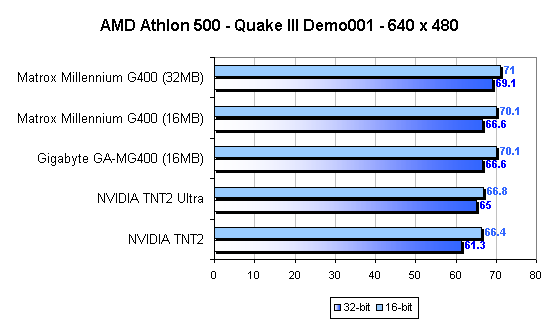

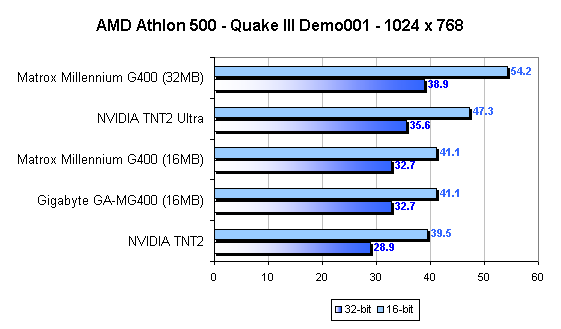
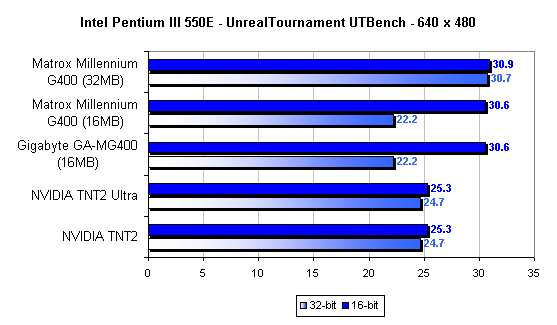
The Unreal Tournament engine limits the performance of all of the contenders here, but it does help to illustrate the benefit of having that extra 16MB of SGRAM. The 16-bit performance of the MG400 is excellent here, but switching to 32-bit color drops the performance of the MG400 a good 35%, and this is only at 640 x 480.
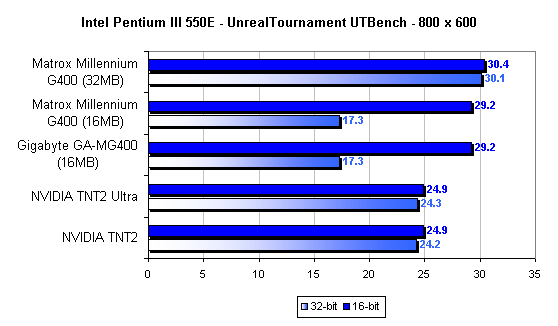
We get a similar situation at 800 x 600, the strong D3D performance of the G400 core puts the MG400 ahead of the two NVIDIA competitors in 16-bit rendering, but the switch to 32-bit color takes its toll out on the 16MB of SGRAM on the board.
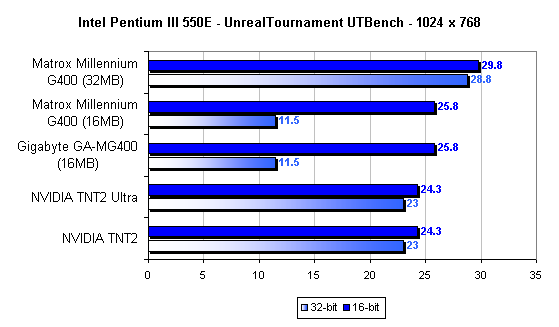
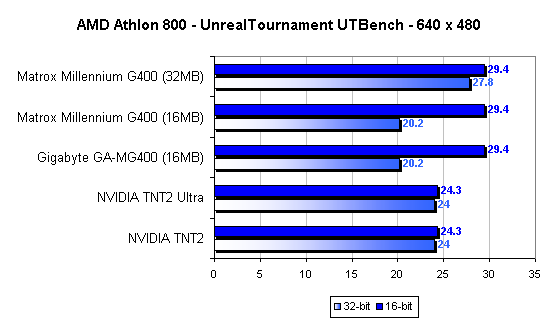
We get similar standings with the Athlon 800, the MG400 comes out on top in 16-bit color performance but the 16MB board suffers in 32-bit color. The 32MB version of the board should do just fine here.
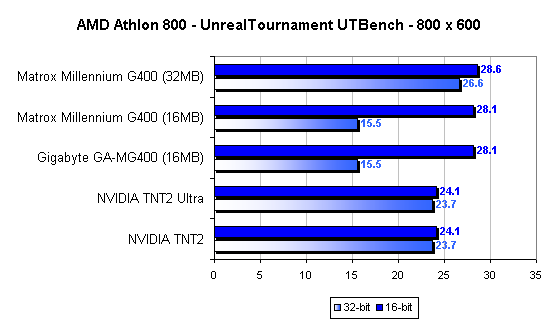
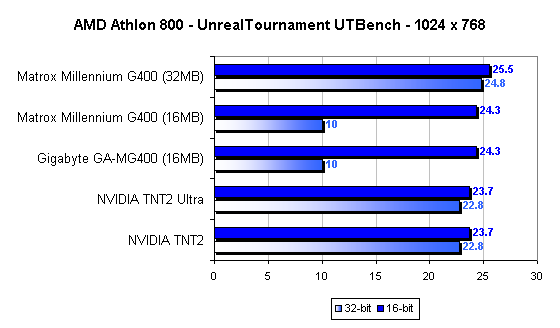
What does 10 fps at 1024 x 768 x 32 bit color translate into? Go for the 32MB version of the card, it's worth the extra $30 :)
The standings change with the Athlon 500, but the performance numbers are all within 1 fps of one another in the 16-bit color tests so the change in standings is insignificant.
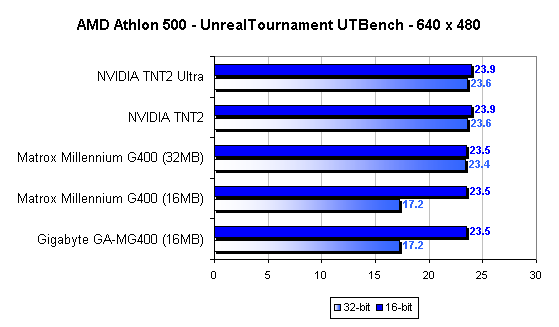
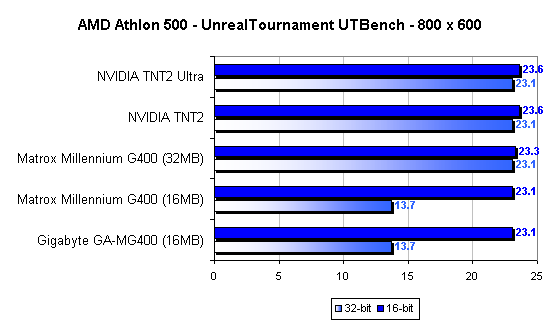
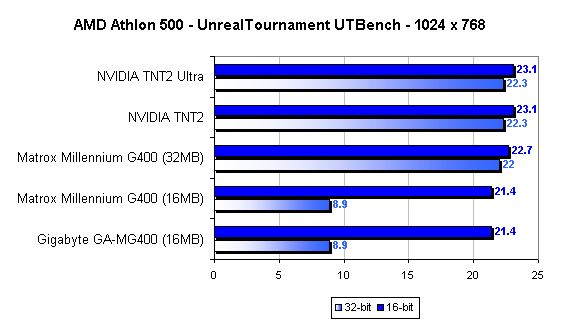
Conclusion
If you currently have a Gigabyte motherboard that supports the VGA BIOS on Motherboard feature required by the MG400 and are looking for a new video card with performance in the TNT2 range, then the MG400 is definitely for you. The one recommendation we will make that stands across the board is that if you are going to be purchasing the MG400, go for the 32MB version which should perform identically to the 32MB Millennium G400 used in our tests. As our benchmarks consistently show, the 16MB of the base MG400 just doesn't cut it at most resolutions especially if you are running in 32-bit color. The extra $30 is worth the performance gain you get out of it.
Compared to the regular G400s from Matrox, the MG400 is a steal. At $120 for a 32MB card, the MG400 comes in a full $60 cheaper than a 32MB Millennium G400. The only thing that $60 buys you is DualHead support with the Millennium G400, if you don't really care about DualHead support then the MG400 is a pretty good deal. Unfortunately if you don't already have a supported Gigabyte motherboard, then the deal loses some of its appeal because you now have to purchase a new motherboard for your new video card. If you were going to upgrade your motherboard regardless, this may be an added incentive to go with a Gigabyte board, but then it does severely limit your motherboard choices.
In the end, the MG400 is an added benefit granted to Gigabyte motherboard owners and if you happen to own one of those motherboards then the MG400 isn't a bad deal at all. If you don't happen to own a supported Gigabyte motherboard, and aren't in the market for a new Gigabyte motherboard, then the MG400 is stripped of its attractive cover and becomes nothing more than a video card without a BIOS.

